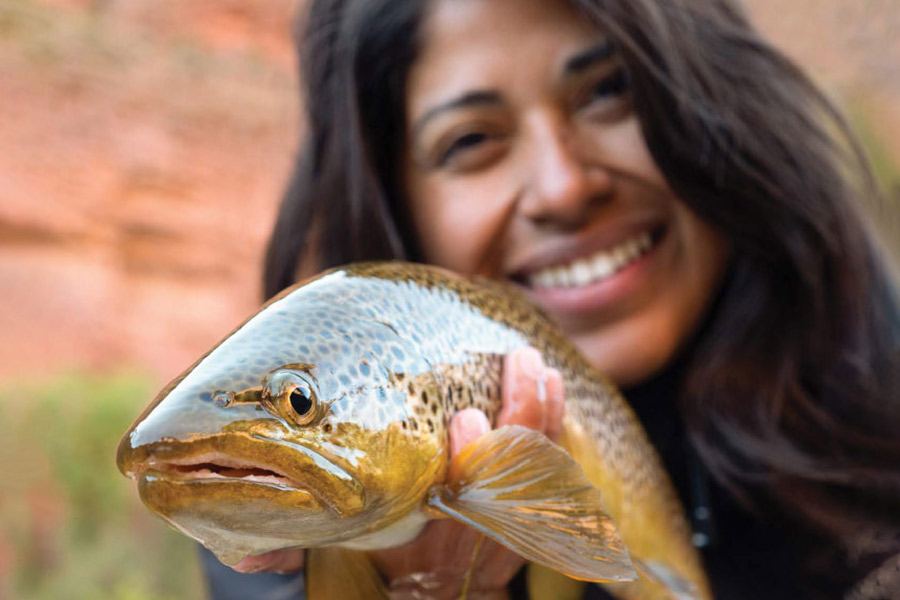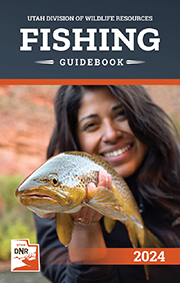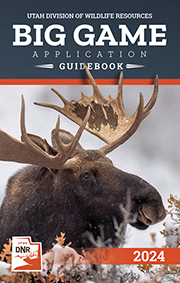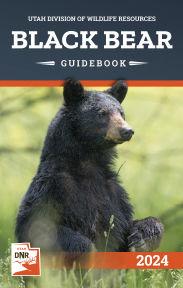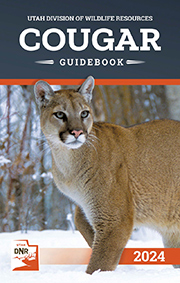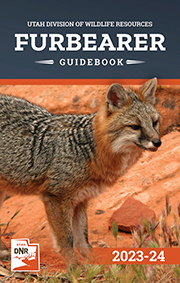Rules & regulations
These guidebooks contain the information you must know to hunt or fish in Utah. We highly recommend that you either download electronic versions or pick up printed copies. We distribute free printed guidebooks at Division offices and licensing agents.
- Hunt boundary maps: View interactive maps of most hunt unit boundaries.
- Wildlife statutes & administrative rules: The regulations written into the wildlife guides are largely taken from state statute and division administrative rules.
- Wildlife calendar: Take a quick look at application dates, deadlines and season dates.
Fishing Guidebook
The Utah Fishing Guidebook summarizes the laws and rules that govern fishing in Utah.
Previous editions
View guidebook updates
— Important changes and corrections made after the guidebook was printed.
Emergency changes
Fall Creek and its tributaries, including Phinney and Anderson lakes (Duchesne County)
- 16 trout, any species
The Division will be treating Fall Creek and its tributaries, including Phinney and Anderson lakes, with rotenone in summer 2025. This will be done to remove non-native fish to assist with cutthroat trout restoration efforts. This emergency change will allow the public to harvest more fish from the drainage in advance of the treatment.
All other rules established in the 2024 and 2025 Utah Fishing Guidebooks remain in effect.
Panguitch Lake (Garfield County)
- Open to fishing
Effective April 22, 2024: Panguitch Lake has reopened to fishing, effective April 22. However, the Garfield County Sheriff's Office is still requesting that people stay away from the dam area of the lake.
All other rules established in the 2024 Utah Fishing Guidebook remain in effect.
Mayor's Pond (Box Elder County)
The daily fish limit for Mayor’s Pond has been updated to eight fish per person through Jan. 31, 2024. Mayor's Pond is listed in the "Community fishing waters" information box on page 28. This emergency change will allow the public to harvest more fish in advance of the pond being dredged.
This change is effective Dec. 20, 2023 and will remain in effect until January 31, 2024. All other rules established in the 2024 Utah Fishing Guidebook remain in effect.
Big Game Application Guidebook
The Utah Big Game Application Guidebook provides information and instructions hunters need to know to apply for bucks, bulls and once-in-a-lifetime hunts.
Previous editions
View guidebook updates
— Important changes and corrections made after the guidebook was printed.
Corrections
Page 70: In the CWMU buck deer hunt table, one Little Red Creek (DB1258) public permit was listed in error. There is no public permit available on that CWMU for 2024, and that hunt has been deleted in the online edition of this guidebook.
Big Game Field Regulations Guidebook
The Utah Big Game Field Regulations Guidebook summarizes the laws and rules that govern big game hunting in Utah.
Previous editions
View field regulation updates
— Important changes and corrections made after the guidebook was printed.
Updates
Page 28: An update to the wildlife management and waterfowl management areas that will be closed to the general public (including big game hunting) for sponsored youth and beginner pheasant hunts was made after the printed guidebook was distributed.
The 2024 closures are:
- Oct. 26 — Huntington Game Farm (until 3 p.m.)
- Nov. 9 — Annabella, Pahvant, Pine Canyon (also known as Carr Fork) WMAs and part of the Ogden Bay WMA
The online edition of the guidebook has been edited to reflect this update.
Corrections
Page 44: The correct dates for the elk muzzleloader multi-season hunt are Oct. 30–Nov. 7 (the end date was listed incorrectly in the printed edition of the guidebook as Nov. 9). Hunter permits, the Hunt Planner and all other instances in the guidebook list the correct dates. The online edition of the guidebook has been edited to reflect this correction.
Page 19: The footnote in the "What seasons can youth hunt?" table indicated an incorrect page number for reference. The footnote has been updated to refer to page 38 (instead of page 43). The online edition of this guidebook has been updated with this correction.
Page 54: The Hunter Mentoring Program no longer requires participating youth to be Utah residents. The word "resident" has been deleted from the information box. The online edition of this guidebook has been updated with this correction.
Pages 3 and 24: In the description of the new muzzleloader regulations, the guidebook language as printed was unclear about how those rules apply to HAMSS hunts. Those descriptions have been edited to reiterate that no scopes of any kind are allowed on HAMSS hunts. The online edition of the guidebook has been edited to reflect these updates.
Page 32: Minor corrections were made to the section describing the use of trail cameras on private land to align more closely with Utah Code § 23A-5-307: A trail camera using internal data storage and not capable of transmitting data is permitted for use on private lands for the purposes of taking protected wildlife. The online edition of the guidebook has been edited to reflect these changes.
Page 43: An incorrect end date for the general-season archery elk hunt was printed in the guidebook. Utah's general season archery spike elk hunt runs from Aug. 17—Sept. 6, 2024 (not Sept. 5, as was indicated in the print edition). The online edition of this guidebook has been updated with this correction.
Upland Game and Turkey Guidebook
The Utah Upland Game and Turkey Guidebook summarizes the laws and rules that govern upland game and turkey hunting in Utah.
Previous editions
View guidebook updates
— Important changes and corrections made after the guidebook was printed.
Corrections
Page 31: The Hunter Mentoring Program no longer requires participating youth to be Utah residents. The word "resident" has been deleted from the information box. The online edition of this guidebook has been updated with this correction.
Page 40: An incorrect end date for the gray (Hungarian) partridge season was printed in the guidebook. The correct season dates are Sept. 28, 2024–Feb. 15, 2025 (not Feb. 15, 2024, as was indicated in the print edition). The online edition of this guidebook has been updated with this correction.
Waterfowl Guidebook
The Utah Waterfowl Guidebook summarizes the laws and rules that govern waterfowl hunting in Utah.
Previous editions
View guidebook updates
— Important changes and corrections made after the guidebook was printed.
Updates
Pages 4, 16 and 30:
Due to limited staffing, the Bear River Migratory Bird Refuge has modified the swan check station hours to Fridays and Saturdays from 9 a.m.–noon and 2–7 p.m. only.
The online edition of this guidebook has been updated with this information.
Black Bear Guidebook
The Utah Black Bear Guidebook summarizes the laws and rules that govern black bear hunting in Utah.
Previous editions
View guidebook updates
— Important changes and corrections made after the guidebook was printed.
Corrections
Page 18: The Hunter Mentoring Program no longer requires participating youth to be Utah residents. The word "resident" has been deleted from the information box. The online edition of this guidebook has been updated with this correction.
Cougar Guidebook
The Utah Cougar Guidebook summarizes the laws and rules that govern hunting and pursuing cougars in Utah.
Previous editions
View guidebook updates
— Important changes and corrections made after the guidebook was printed.
Corrections
Page 14: A section of the guidebook pertaining to prohibited weapons as referenced in the big game rule (R657-5-7) was deleted. Under the current cougar rule, legal weapons are subject to Utah Administrative Rules 657-5-8 through -11, which remain in the guidebook as published. The online edition of the guidebook has been updated with this change.
Furbearer Guidebook
Taking, possessing, selling and purchasing furbearing animals, including bobcats and martens.
Previous editions
View guidebook updates
— Important changes and corrections made after the guidebook was printed.
Corrections
Page 16: In the "Trap restrictions to protect river otters" information box, the correct trapping-device restriction distance from certain waterbodies is 600 yards (not 100 yards as was indicated in the print edition).
The online edition of this guidebook has been updated with this correction.


